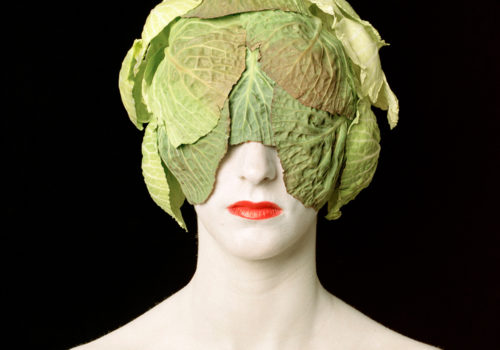For over twenty years, Patty Carroll has staged photographs using models, drapery, and household objects to create humorous, provocative photographic tableaux that comment on the role of women at home. Anonymous Women, published by Daylight Books, presents images of women in theatrical domestic scenes where their true identity is lost in the trappings of domesticity. These not-so-still-lifes are colorful, beautiful, and mysterious, articulating the many complex relationships, both personal and cultural, existing between women and the home.
What drove you to start this project?
The Anonymous Women project began while living in England, where my identity was determined by my domestic position. I found that in a more traditional culture than the United States, one’s domestic status often eclipses one’s professional or personal sense of self. Making photographs of vulnerable, stark heads hiding behind various domestic objects were my initial response to this predicament.
Returning home to live in the USA, while re-making a home and identity, home furnishings came to represent personal conflicted realms of laughter and sadness. Home-making, whether through physical renovation or by an internal sense of comfort, remains a constant, universal subject for many women. Whether external threats to safety and security are real or not, the home remains a place of peace. “Staying home” can be also a response for many women when life seems too overwhelming. The drapery pictures are about becoming the dwelling itself. I am addressing the sharp edges of domesticity: the home as a place of comfort, or a place where decoration becomes an obsession, where the woman is camouflaged by her domestic interior rendering her invisible. Comfort and safety are values that have grown in importance in our society, with claustrophobic or therapeutic consequences!
The drapery work was made when the war with Iraq was building. Issues of vulnerability, trust, safety, courage and absurdity weighed heavily on my mind then, and continue to linger daily. I think about the women who encounter real wars, internal conflicts, domestic abuse, and other threats – real or imagined. I also laugh at myself and other women, when we lose perspective and become possessed by our material goods.
In all cases, women need “A room of their own.” The images reference draped statues from the Renaissance, nuns in habits, women wearing the burka, the Virgin Mary, priests’ robes, ancient Greek and Roman dress, as well as judges’ robes.
Do you see it at the intersection of fashion and sociology?
Yes, absolutely. We women seem to always want to be beautiful, but we also want to be professional, respected, relevant and think independently. This work is about the larger state of women roles and their concerns, especially as it relates to the home, and all the conflicting issues surrounding it.
Do you feel influenced by fashion photography codes and esthetics?
Yes, and of course, no. Fashion photography can be extremely beautiful and inspiring, but is often based on other ideas. Nevertheless, as often as I am tired of fashion, I am equally fascinated and thrilled by it. In some ways this is about subverting fashion photography because you never see the model’s face, never see how the beautiful people are. Because the photographs are visually stimulating, they take some cues from fashion photography, but not the same content. I want my photographs to be both a critique and celebration of obsession, beauty and domesticity.
Were you interested in investigating the woman’s place in different cultures?
I think all women (no matter what culture) have the same issues. We are mothers, aunts, grandmothers, daughters etc. who have hopes, aspirations, family, jobs, work that is both family and non-family, as well as issues and conflicts with all of it. We live in a complicated, contemporary society. Even in places that are more traditional or restricted, no matter what class or economic situation, women have many of the same problems and concerns worldwide. Having said that, living in a more traditional society, led me to thinking about all of this. If these pictures can touch women in some way, I have succeeded.
Do you shoot with real women whose personal history you reflect in your work?
No, although there are real women as the models, the photographs are not specifically about them. The pictures are about types of women rather than particular stories. Each of the images are really imaginary people based on many ideas and stories.
Interview by Myrtille Beauvert
Patty Carroll, Anonymous Women
Published by Daylight Books
$45
















